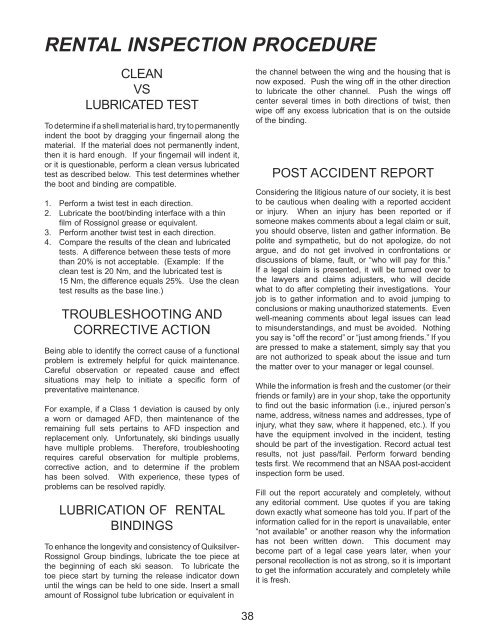rental inspection procedure - Rossignol
rental inspection procedure - Rossignol
rental inspection procedure - Rossignol
You also want an ePaper? Increase the reach of your titles
YUMPU automatically turns print PDFs into web optimized ePapers that Google loves.
RENTAL INSPECTION PROCEDURE<br />
CLEAN<br />
VS<br />
LUBRICATED TEST<br />
To determine if a shell material is hard, try to permanently<br />
indent the boot by dragging your fingernail along the<br />
material. If the material does not permanently indent,<br />
then it is hard enough. If your fingernail will indent it,<br />
or it is questionable, perform a clean versus lubricated<br />
test as described below. This test determines whether<br />
the boot and binding are compatible.<br />
1. Perform a twist test in each direction.<br />
2. Lubricate the boot/binding interface with a thin<br />
film of <strong>Rossignol</strong> grease or equivalent.<br />
3. Perform another twist test in each direction.<br />
4. Compare the results of the clean and lubricated<br />
tests. A difference between these tests of more<br />
than 20% is not acceptable. (Example: If the<br />
clean test is 20 Nm, and the lubricated test is<br />
15 Nm, the difference equals 25%. Use the clean<br />
test results as the base line.)<br />
TROUBLESHOOTING AND<br />
CORRECTIVE ACTION<br />
Being able to identify the correct cause of a functional<br />
problem is extremely helpful for quick maintenance.<br />
Careful observation or repeated cause and effect<br />
situations may help to initiate a specific form of<br />
preventative maintenance.<br />
For example, if a Class 1 deviation is caused by only<br />
a worn or damaged AFD, then maintenance of the<br />
remaining full sets pertains to AFD <strong>inspection</strong> and<br />
replacement only. Unfortunately, ski bindings usually<br />
have multiple problems. Therefore, troubleshooting<br />
requires careful observation for multiple problems,<br />
corrective action, and to determine if the problem<br />
has been solved. With experience, these types of<br />
problems can be resolved rapidly.<br />
LUBRICATION OF RENTAL<br />
BINDINGS<br />
To enhance the longevity and consistency of Quiksilver-<br />
<strong>Rossignol</strong> Group bindings, lubricate the toe piece at<br />
the beginning of each ski season. To lubricate the<br />
toe piece start by turning the release indicator down<br />
until the wings can be held to one side. Insert a small<br />
amount of <strong>Rossignol</strong> tube lubrication or equivalent in<br />
38<br />
the channel between the wing and the housing that is<br />
now exposed. Push the wing off in the other direction<br />
to lubricate the other channel. Push the wings off<br />
center several times in both directions of twist, then<br />
wipe off any excess lubrication that is on the outside<br />
of the binding.<br />
POST ACCIDENT REPORT<br />
Considering the litigious nature of our society, it is best<br />
to be cautious when dealing with a reported accident<br />
or injury. When an injury has been reported or if<br />
someone makes comments about a legal claim or suit,<br />
you should observe, listen and gather information. Be<br />
polite and sympathetic, but do not apologize, do not<br />
argue, and do not get involved in confrontations or<br />
discussions of blame, fault, or “who will pay for this.”<br />
If a legal claim is presented, it will be turned over to<br />
the lawyers and claims adjusters, who will decide<br />
what to do after completing their investigations. Your<br />
job is to gather information and to avoid jumping to<br />
conclusions or making unauthorized statements. Even<br />
well-meaning comments about legal issues can lead<br />
to misunderstandings, and must be avoided. Nothing<br />
you say is “off the record” or “just among friends.” If you<br />
are pressed to make a statement, simply say that you<br />
are not authorized to speak about the issue and turn<br />
the matter over to your manager or legal counsel.<br />
While the information is fresh and the customer (or their<br />
friends or family) are in your shop, take the opportunity<br />
to find out the basic information (i.e., injured person’s<br />
name, address, witness names and addresses, type of<br />
injury, what they saw, where it happened, etc.). If you<br />
have the equipment involved in the incident, testing<br />
should be part of the investigation. Record actual test<br />
results, not just pass/fail. Perform forward bending<br />
tests first. We recommend that an NSAA post-accident<br />
<strong>inspection</strong> form be used.<br />
Fill out the report accurately and completely, without<br />
any editorial comment. Use quotes if you are taking<br />
down exactly what someone has told you. If part of the<br />
information called for in the report is unavailable, enter<br />
“not available” or another reason why the information<br />
has not been written down. This document may<br />
become part of a legal case years later, when your<br />
personal recollection is not as strong, so it is important<br />
to get the information accurately and completely while<br />
it is fresh.


